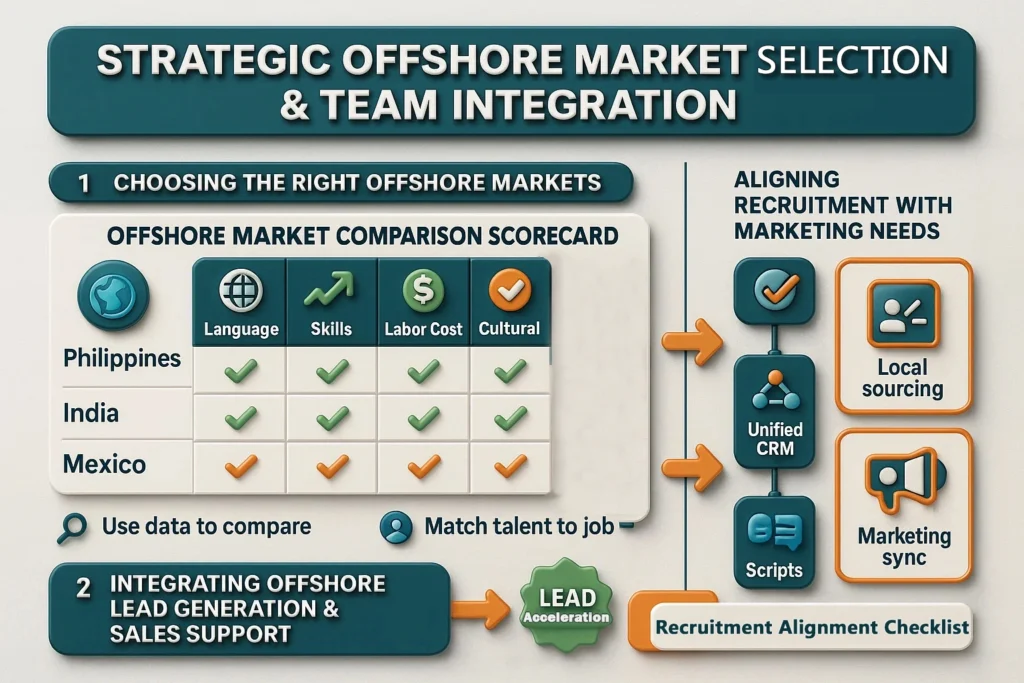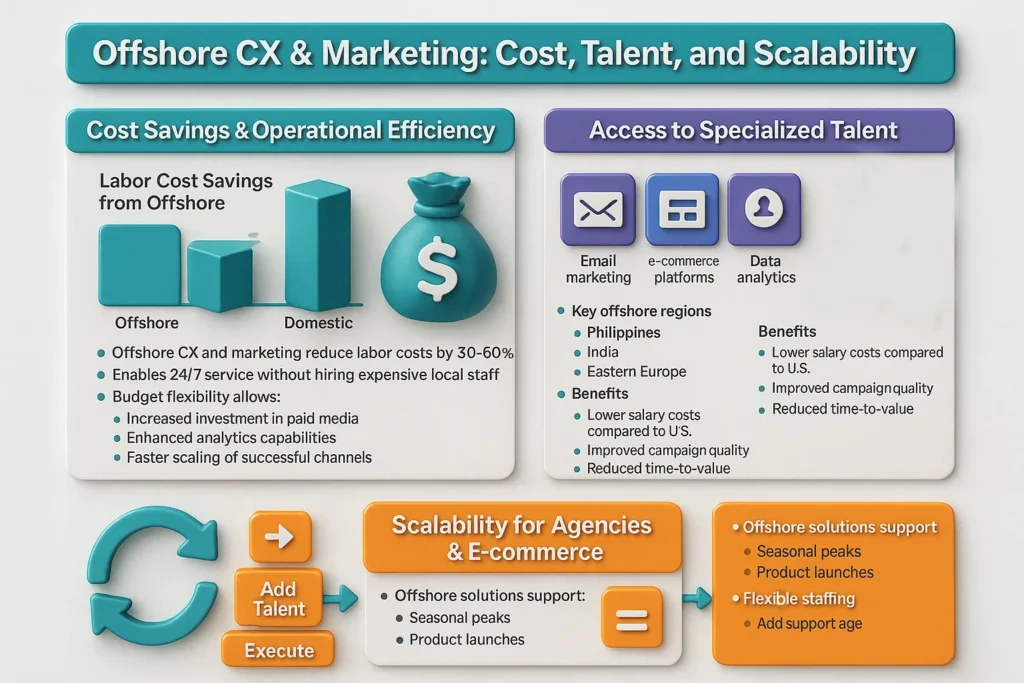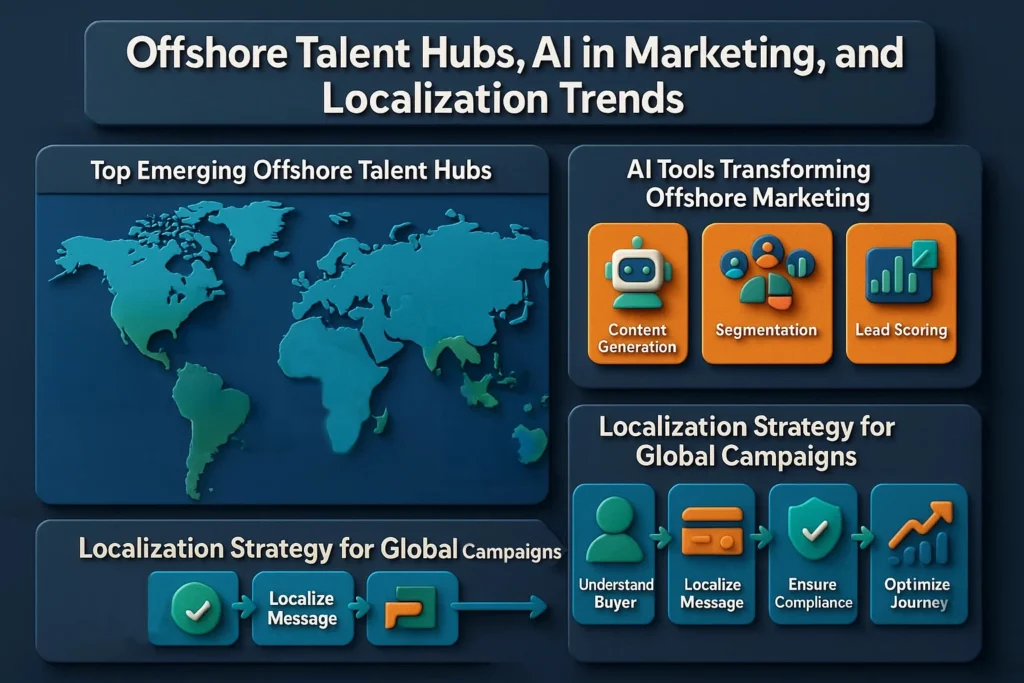65% of U.S. mid-market companies that expanded internationally in the last five years say offshore marketing actually helped. They cut customer acquisition costs by at least 30% and boosted conversion rates. This shows how powerful offshore marketing can be for growing globally.
This case study shows how offshore marketing helps U.S. growth leaders and marketers enter new markets. It includes offshore lead generation, sales support, ecommerce solutions, and cost savings in customer experience. It also involves hiring specialized offshore talent, like email marketing specialists and virtual assistants.
Your goal is clear: use proven strategies to measure offshore marketing’s impact on global growth. You’ll learn how to replicate successes and manage risks. This section outlines the main idea and what to expect in the playbook, including steps, metrics, and trade-offs for global expansion.

Offshore marketing is key to growing your business worldwide. It means using teams in places like the Philippines or Mexico for marketing tasks. This approach is different from using local teams because of cost and time zone differences.
Offshore marketing helps you grow without the high costs of local teams. It lets you create campaigns that fit local markets and languages. This way, you can enter new markets quickly and keep customer interactions smooth.
Offshore marketing helps you reach your goals like cutting costs and getting to market fast. It lets you find the right talent for your campaigns. This way, you can offer better customer service and grow your business quickly.
Keep track of important numbers to see how offshore marketing works. Look at how much it costs to get a new customer compared to local teams. Also, check how well your campaigns are doing by looking at things like email success.
Watch how fast your team responds to customers and how happy they are. Also, see how much money you make from using offshore teams. These numbers show how offshore marketing helps your business grow globally.

To grow globally, you need a solid plan. Start by picking markets based on solid data. Look at language, culture, labor costs, talent, and more. Places like the Philippines and India are great for certain tasks.
First, use numbers to narrow down your choices. Look at language, skills, and labor costs. Then, add in cultural fit and who your buyers are. A scorecard helps you compare places like the Philippines and India.
Match talent to the jobs you need. For email marketing, look for places with strong digital training. For sales support, focus on time zones and English skills.
Make sure processes work smoothly across borders. Use one CRM for everyone to see the same data. Set clear goals and how to move leads forward.
Hold regular meetings and use clear guides. Give offshore teams scripts for their work. This helps move leads faster and boosts sales.
Recruitment should match your marketing goals. Use local experts to find the right people fast. Test candidates with real tasks to see if they fit.
Use tests that mimic real work. For email marketing, check their skills in sending emails and writing. Working with trusted BPOs helps you find good people quickly.

Offshoring marketing functions helps you grow efficiently. It lowers costs while keeping quality high. This lets you invest more in activities that boost revenue across markets.
Offshoring customer experience and routine marketing can cut labor costs by 30–60%. This creates room for more paid media and analytics. You can also offer 24/7 service without adding expensive local staff.
Lower costs mean more flexible budgets. This flexibility helps fund pilots and scale successful channels faster than with domestic resources.
Offshore markets have deep pools of specialists in email, e-commerce, and analytics. You can hire an offshore email marketing specialist for better segmentation and automation. Agencies and brands find strong Shopify and Magento support, plus marketing analysts who make data actionable.
Working with experienced teams in places like the Philippines, India, and Eastern Europe gives you specialist skills without the high U.S. salaries. This improves campaign quality and shortens time-to-value.
Scalable offshore ecommerce solutions and virtual assistants help you scale for seasonal peaks or product launches. You can quickly add support agents or content creators for a quarter and then scale down.
Outsourcing email marketing strategy offshore speeds up A/B testing and personalization. This improves open rates and conversions while keeping costs low. This agility supports the broader benefits of offshore marketing for global growth by enabling responsive, data-driven expansion.
When you combine cost savings, specialist access, and flexible scaling, offshore marketing becomes a practical tool. It helps you accelerate market entry and improve unit economics.

When you expand globally, your team needs to meet local and global standards. Start by creating a clear hiring process. This should move candidates from the first screening to work-sample tests and interviews.
Make sure job descriptions fit the local culture and time zone. Work with trusted local recruitment agencies to find the best candidates quickly. Consider visa rules and the difference between contractor and employee contracts.
Create a detailed recruitment process focused on finding top talent offshore. Use tests for technical skills and work samples for marketing roles. Live task sessions help evaluate practical skills.
Include reference checks and use partner agencies for background checks when allowed. Offer clear contracts for both contractors and employees. Make sure terms align with tax and visa laws.
Focus on hiring for roles that impact your business. Look for offshore email marketing specialists for campaign strategy and list health. Add offshore sales support for lead qualification and closing regional gaps.
Consider hiring VAs for administrative tasks and campaign operations. Also, add analytics and ecommerce specialists for complete attribution and execution.
Use a 60–90 day onboarding plan to build skills. Start with documented SOPs and training on tools. Include shadowing and QA checks to catch issues early.
Link continuous learning to performance reviews and KPIs. Use quality frameworks and scorecards for assessments. Campaign audits and regular feedback sessions keep remote teams on track.
Stage | Key Activities | Tools & Metrics |
Attract | Localized job specs, offshore recruitment lead generation, agency sourcing | Applicant flow rate, time-to-fill, source conversion |
Assess | Competency tests, work-sample assessments, behavioral interviews | Task scores, interview ratings, technical pass rate |
Offer & Hire | Contract vs. employee terms, visa and tax checks, offer negotiation | Offer acceptance rate, compliance checklist completion |
Onboard (0–30 days) | Platform access, SOPs, shadowing with senior staff | Completion rate, initial QA score, knowledge checks |
Ramp (31–90 days) | Live tasks, campaign ownership, fortnightly calibration | Performance vs. KPI, campaign error rate, quality scorecards |
Scale & Maintain | Continuous learning, performance reviews, analytics handoffs | Retention rate, ROI per FTE, improvement in KPIs |
You need a focused approach to turn international interest into qualified opportunities. Start with local research, add repeatable email systems, and tie both into offshore sales support. This way, your pipeline converts reliably across markets.
Do market-specific keyword research with tools like SEMrush, Ahrefs, and Google Search Console. Find search intent and seasonal trends. Use local keyword planners for colloquial terms and search volume differences.
Choose a domain strategy that matches your goals. Country-code domains (ccTLDs) build trust. Subfolders scale central authority while keeping regional pages on your main domain. Implement hreflang tags to prevent duplicate-content issues and guide search engines to the right language variants.
Create culturally relevant creatives and copy. Adapt imagery, headlines, and CTAs to local norms. Monitor local search trends weekly and update content priorities based on real queries and performance.
Segment lists by behavior, firmographics, and lifecycle stage to increase relevance. Use automation flows for welcome sequences, nurture tracks, and cart abandonment. This moves prospects down the funnel.
Run controlled A/B tests on subject lines, visuals, and CTAs to raise open and click rates. Maintain deliverability hygiene with regular list cleaning and sender reputation monitoring. Hiring an offshore email marketing specialist lets you scale campaigns and keep deliverability strong.
Equip offshore BDRs and SDRs with clear playbooks. Define qualification criteria and handoff triggers. Integrate CRM tasks and automated cadences for a multi-channel approach.
Set measurable handoff criteria, such as budget, timeline, and authority. Use localized scripting and objection-handling templates. This ensures conversations reflect cultural expectations and buying behavior.
Track conversion metrics and iterate on cadence, messaging, and handoff points. When offshore lead generation, outsource email marketing strategy, and offshore sales support work together, you reduce friction. This scales predictable international growth.

You need a tech stack that keeps teams together and works fast. Use Slack or Microsoft Teams for daily chats, Zoom for meetings, and Notion or Confluence for rules. Add a CRM like Salesforce or HubSpot for tracking leads and setting roles.
Make sure your calendar and meeting rules work for everyone, no matter where they are. This helps your team work smoothly together.
Collaboration platforms should work well with your CRM. Set up Salesforce or HubSpot to track leads and manage tasks. Use clear names and rules in Notion to avoid mistakes as your team grows.
Use tools like Google Analytics 4 for website data, Looker Studio for reports, and Tableau or Power BI for deep analysis. Add tools like Adjust or AppsFlyer for mobile ads to see what works best.
Make dashboards that show how offshore marketing helps your business. Track leads, conversions, and costs alongside your revenue. This helps you see which markets are best for your money.
Use automation and outsourcing tools to save time. Marketing tools like Marketo and ActiveCampaign help with emails and lists. Zapier or Workato move data automatically, and platforms like Upwork help when you need more hands.
Set up rules for lead handling and follow-ups. Work with trusted partners to speed up your work and make it consistent. Automation and outsourcing help you try new things faster and grow globally.
This case study shows how a U.S. ecommerce firm entered Western Europe on a tight budget. They needed to find the right market, lower costs, and offer 24/7 customer service without big overhead. It offers practical steps for your own growth.
The company sold premium home goods on Shopify and aimed at Germany and the Netherlands. They wanted to launch fast and cheaply. Their goals were to cut customer acquisition costs by 25%, find the right market in three months, and offer 24/7 customer service. Offshore solutions handled orders, returns, and regional shipping.
An offshore email marketing expert built welcome and cart-abandonment emails. They used native Dutch and German copywriters for better search intent. Paid search campaigns targeted specific cities and devices with localized landing pages.
Offshore sales support qualified B2B leads and passed high-value ones to the U.S. team. Virtual assistants managed product listings, inventory, and basic customer service. This mix of offshore solutions and digital campaigns created a lean launch engine.
In 12 weeks, CAC dropped by 31% compared to domestic launches. Conversion rates rose 18% with localized emails and landing pages. Email open rates jumped from 14% to 26%, and click rates doubled after language and timing tweaks.
Time-to-market was six weeks shorter thanks to offshore solutions for fulfillment and returns. Using VAs and offshore sales support cut CX costs by 40% while keeping response times under two hours for EU queries. These wins allowed scaling without adding too many people.
The key takeaways are clear: focus on deep localization, set tight KPIs for offshore lead generation and CX, and scale in phases for quick iteration. This approach shows how offshore marketing can drive growth and improve operations.
Metric | Baseline (pre-launch) | After 12 weeks | Change |
Customer acquisition cost (CAC) | $48 | $33 | -31% |
Conversion rate (site) | 1.8% | 2.12% | +18% |
Email open rate | 14% | 26% | +12pp |
Email click-through rate | 1.5% | 3.1% | +107% |
Time-to-market (weeks) | 16 | 10 | -6 weeks |
CX operating cost | $12,000/month | $7,200/month | -40% |
Qualified B2B leads routed | 40/month | 95/month | +137% |

Offshore marketing needs to be treated as a disciplined operation. Start by mapping data flows, vendor interactions, and applicable laws. This will guide steps on data protection, quality, and contingency planning.
Following GDPR, UK Data Protection Act, and CCPA is essential for EU, UK, and U.S. data. Check local data rules in markets like Germany, Brazil, and India before moving data.
Use strong encryption for data. Have Data Processing Agreements with vendors and conduct due diligence. Keep consent records and use localized privacy notices.
Set measurable KPIs for performance and compliance. Track SLA adherence, lead quality, conversion rates, and more.
Run regular QA audits and use scorecards. Review interactions and apply corrective actions when needed. Use dashboards for KPIs and compliance flags.
Create redundancy with multi-hub staffing. Have backup vendors and document knowledge transfer for critical workflows.
Cross-train teams and maintain crisis communication protocols. Test failover plans and tabletop exercises to prepare for incidents.
By focusing on data privacy, managing risks, and compliance, you can grow internationally while protecting customers and your brand.

Keep an eye on offshore marketing trends. They’re changing how we hire, use tools, and meet customer needs. These changes impact your costs, how fast you can market, and how relevant your campaigns are.
Vietnam and the Philippines are now top for customer service and ecommerce. They have fast teams and strong English skills for global brands.
Poland and Romania are great for tech and B2B marketing talent. Their skills fit well with product growth, SaaS needs, and complex campaigns.
Colombia and Mexico are becoming key nearshore spots for U.S. brands. They offer timezone matching, cultural understanding, and easier payment handling for regional teams.
AI is changing offshore marketing with AI content and creative tests. It also helps with automated segmentation and lead scoring for top prospects.
AI chatbots help offshore CX teams by handling simple questions. This lets them focus on strategy and optimization.
Buyers want messages that feel local, support many languages, and quick responses. Your campaigns need to show cultural understanding, local payment options, and follow local rules.
Use local insights in your creative work and customer journeys. This approach meets local needs and boosts conversions in new markets.
To get value from offshore teams, follow a clear, data-driven plan. Start by assessing tasks and setting goals tied to KPIs. Run short pilots to guide phased growth. This method helps grow offshore marketing while keeping control.
Use a decision matrix to score tasks. Look at strategic importance, process maturity, regulatory sensitivity, and cost-saving. Score each function from 1–5 on these points. Start with tasks like email operations and lead qualification.
Keep core strategy and brand positioning in-house. Here’s a matrix to help you decide.
Function | Strategic Importance | Process Maturity | Regulatory Sensitivity | Cost-saving |
Email operations | 2 | 5 | 2 | 5 |
Lead qualification | 3 | 4 | 2 | 4 |
Basic customer support (CX) | 3 | 4 | 3 | 4 |
Sales strategy and complex negotiations | 5 | 2 | 4 | 2 |
Ecommerce platform development | 4 | 3 | 3 | 3 |
Set SLAs for outcomes like response times and lead follow-up. Make KPIs clear for team success. Use response-time SLAs for CX and lead-follow windows for sales support.
Match reporting cadences to your operation’s pace. Have daily huddles, weekly reviews, and monthly strategic meetings. Share dashboards with live metrics with stakeholders.
Start with an 8–12 week pilot with clear goals and KPIs. Use pilot results to improve processes and training. If successful, scale by adding more people and markets.
Transition to an incorporated offshore center when volume and complexity grow. Consider legal and HR needs. Phased growth helps manage ROI and risk.
This roadmap improves predictability. It supports scaling offshore marketing without losing quality. Data-driven choices lead to better growth with offshore marketing.
Offshore marketing is key to growing globally when you mix strategy with discipline. It’s a smart, cost-effective way to grow your business. You can reach more customers, find specialized talent, and grow without the high costs of new offices.
Start by picking markets based on data. Then, hire and check the skills of your offshore team. Use the right tech, set clear goals, and track your progress with strict KPIs. Test small before going big to manage risks and ensure success.
By focusing on lead generation, sales support, ecommerce, and VAs for agencies, you can grow globally while saving money. Make sure to keep quality high, follow rules, and report regularly. This way, you can trust your brand as you reach more people worldwide.
Offshore marketing means doing marketing tasks in places like the Philippines or India. This helps U.S. companies save money and reach more people. By using teams in these places, companies can work across time zones and find specialized talent.
When you use offshore teams for tasks like lead generation and email marketing, you can grow faster. This approach lowers the cost of getting new customers and helps increase the value of each customer.
The fastest gains come from tasks like lead generation, email marketing, and basic customer service. These tasks are easier to do remotely and can be improved quickly. For example, hiring someone to handle your email marketing can make your campaigns better.Also, using virtual assistants for tasks like order processing can help you handle busy times without spending a lot of money.
Look at things like language, culture, talent, and cost. You want a place that fits your needs and has the right people. Places like the Philippines or India are good for certain tasks.Don't just pick the cheapest place. Think about what you need and where you can find the best talent.
Use a CRM like Salesforce to keep everything in one place. Make sure your offshore teams know how to use it. Have regular meetings and clear rules for how to work together.Use tools to track how well your teams are working together. This helps make sure leads are handled smoothly from start to finish.
Look at things like how much it costs to get a new customer and how well your teams are doing. Also, check how fast leads turn into customers and how happy your customers are.Make sure your offshore teams are meeting their goals and doing a good job.
You can save a lot of money by using offshore teams. The exact amount depends on where you go. But, you can use that money to do more marketing and reach more people.Just make sure you're not cutting corners to save money. Invest in good people and training.
Start by making clear job descriptions and working with good recruiters. Then, test their skills and interview them. Make sure they can do the job well.For important jobs like email marketing, test their skills in those areas. Decide if you want to hire contractors or full-time employees.
Give them a good onboarding process with clear instructions and training. Check their work regularly and give feedback. Make sure they know how to do their job well. Keep an eye on their performance and help them learn and grow. This keeps your standards high.
Use local content and SEO, and tailor your email campaigns to each market. Use tools to help you find the right keywords and create content that fits each place. Outsource your email marketing to experts who can help you reach more people. Use offshore sales teams to turn leads into customers.
Use tools like Slack and Zoom for communication. Keep your lead data in one place with a CRM. Use analytics tools to track how well your teams are doing. Marketing automation platforms help you work more efficiently. They also help you see how well your teams are doing.
Follow all the rules about data privacy, like GDPR. Make sure your vendors do too. Use encryption and access controls to keep data safe.Work with lawyers to make sure your contracts are right. Make sure your vendors meet your security standards.
Have a plan for when things go wrong. Have backup teams and vendors ready. Make sure your teams know how to handle emergencies. Have a plan for disasters, like power outages. This helps you keep working even when things are tough.
AI is making marketing better by helping with personalization and predicting what customers want. It can also help with customer service.Plan to use AI to make your marketing better. Make sure your teams know how to use it well.
Start with a small test to see if it works. Then, grow your team and reach more markets. Move from using contractors to having a full team when you need to.Keep track of how well your teams are doing. Have regular meetings to plan and review progress.
Many companies have seen big improvements. They've saved money and reached more customers faster. They've also seen better results from their marketing efforts.Using offshore teams can make your marketing more efficient. It can also help you handle busy times without spending too much.
Places like Vietnam and the Philippines are becoming popular for marketing. Poland and Romania are good for tech and B2B marketing. Latin America is a good choice for reaching the U.S. market.These places are changing, so look for talent that fits your needs. Don't just choose based on cost.
Use a checklist to decide. Look at how important the task is, if it's regulated, and if it's something you can do well remotely. Start with tasks that are easy to do offshore.Keep important tasks like strategy and product development in-house. Check in regularly to see if you need to make changes.
Join thousands of businesses leveraging offshore staffing to scale their operations globally
Expand effortlessly with My Offshore Employees - access top 1% offshore talent starting at just $3/hr or $600/month per FTE. No hidden fees, no compromises on quality. Your offshore employees work exclusively for you - ensuring focus, transparency, and real-time visibility into your projects. We combine smart automation and proven industry experience to deliver higher productivity, fewer errors, and tailor-made solutions for your business growth.
© 2025. All Rights Reserved.